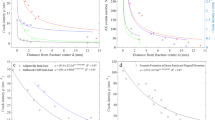Abstract
THE constant 'b value' observed in frequency–magnitude distributions of earthquakes has been taken as an indication of self-similarity at all magnitudes. Hence, earthquake properties should scale uniformly in the same way from small to large earthquakes. It has often been observed, however, that the seismic moment released in small earthquakes scales differently with rupture length than it does for large events1,2, where the crossover between small and large events is defined at a rupture dimension equal to the down-dip width of the seismogenic zone. A possible explanation for this contradiction is that frequency–size distributions are biased by small earthquakes. Small events dominate most global earthquake catalogues because of the short time-period covered. Another source of bias in size distributions is the saturation of earthquake magnitudes for large events. Here we correct biases in calculations of b values and present evidence for a change in b value in frequency–size distributions. We find that a break in self-similarity, from small to large earthquakes, occurs at a point where the dimension of the event equals the down-dip width of the seismogenic layer.
This is a preview of subscription content, access via your institution
Access options
Subscribe to this journal
Receive 51 print issues and online access
$199.00 per year
only $3.90 per issue
Buy this article
- Purchase on Springer Link
- Instant access to full article PDF
Prices may be subject to local taxes which are calculated during checkout
Similar content being viewed by others
References
Scholz, C. H. Bull. Seism. Soc. Am. 72, 1–14 (1982).
Shimazaki, K. in Earthquake Source Mechanics. AGU Geophys. Monogr. 37 (eds Das, S., Boatwright, J. & Scholz, C.) 209–216 (American Geophysical Union, Washington, DC, 1986).
Gutenberg, B. & Richter, C. Seismicity of the Earth and Associated Phenomena, 2nd edn, 310 (Princeton University Press, 1956).
Rydelek, P. A. & Sacks, I. S. Nature 337, 251–253 (1989).
Boatwright, J. & Choy, G. J. geophys. Res. 94, 15541–15553 (1989).
Rundle, J. B. J. geophys. Res. 94, 12337–12342 (1989).
Pacheco, J. F. & Sykes, L. R. Bull. Seism. Soc. Am. (submitted).
Abe, K. Phys. Earth planet. Inter. 27, 72–92 (1981).
Press, W., Flannery, B., Teukolsky, S. & Vetterling, W. Numerical Recipes in C: The Art of Scientific Computing, 735 (Cambridge University Press, New York, 1988).
Geller, R. Bull. Seism. Soc. Am. 66, 1501–1523 (1976).
Akaike, H. IEEE Trans. Autom. Control AC-19, 716–723 (1974).
Rundle, J. B. & Kanamori, H. J. geophys. Res. 92, 2606–2616 (1987).
Kanamori, H. & Anderson, D. Bull. Seism. Soc. Am. 65, 1073–1095 (1975).
Sykes, L. R. J. geophys. Res. 76, 8021–8041 (1971).
Sykes, L. R. & Quittmeyer, R. C. Earthquake Prediction: An International Review, Maurice Ewing Ser. 4 (eds Simpson, D. & Richards, P.) 217–247 (American Geophysical Union, Washington DC, 1981).
Frohlich, C. Ann. Rev. Earth planet. Sci. 17, 227–254 (1989).
Marone, C. & Scholz, C. Geophys. Res. Lett. 15, 621–624 (1988).
Chinnery, M. A. & North, R. G. Science 190, 1197–1198 (1975).
Davison, F. & Scholz, C. Bull. Seism. Soc. Am. 75, 1349–1362 (1985).
Scholz, C. H. in Spontaneous Formation of Space-Time Structures and Criticality (eds Riste, T. & Sherrington, D.) 41–56 (Kluwer, Dordrecht, 1991).
Author information
Authors and Affiliations
Rights and permissions
About this article
Cite this article
Pacheco, J., Scholz, C. & Sykes, L. Changes in frequency–size relationship from small to large earthquakes. Nature 355, 71–73 (1992). https://doi.org/10.1038/355071a0
Received:
Accepted:
Issue Date:
DOI: https://doi.org/10.1038/355071a0
This article is cited by
-
Study on the characteristics of rockbursts in deep-buried tunnels based on microseismic monitoring
Environmental Earth Sciences (2023)
-
Unsupervised machine learning reveals slab hydration variations from deep earthquake distributions beneath the northwest Pacific
Communications Earth & Environment (2022)
-
Earth’s gradients as the engine of plate tectonics and earthquakes
La Rivista del Nuovo Cimento (2022)
-
Potential seismogenic asperities in the Garhwal–Kumaun region, NW Himalaya: seismotectonic implications
Natural Hazards (2021)
-
Estimation of fractal dimension and b-value of earthquakes in the Himalayan region
Arabian Journal of Geosciences (2021)
Comments
By submitting a comment you agree to abide by our Terms and Community Guidelines. If you find something abusive or that does not comply with our terms or guidelines please flag it as inappropriate.



